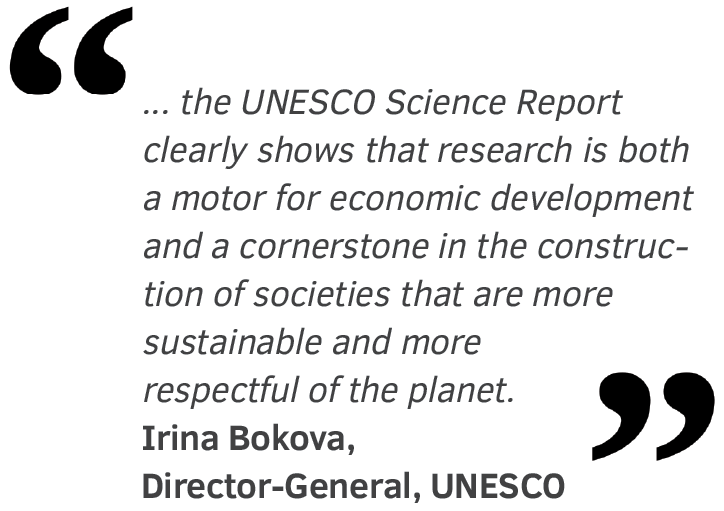he North–South divide in research and innovation is narrowing, says the latest UNESCO Science Report. UNU-MERIT founder Luc Soete presented the executive summary at the launch event at UNESCO headquarters in Paris. The full report is embedded below.
The report includes several contributions by UNU-MERIT fellows, including chapter 1: ‘A World in Search of an Effective Growth Strategy’ by Luc Soete et al; Chapter 2: ‘Tracking Trends in Innovation and Mobility’, by Director Bart Verspagen, Senior Researcher Hugo Hollanders, PhD Fellow Elvis Avenyo, et al; Chapter 9: ‘European Union’, by Researcher Minna Kanerva and Senior Researcher Hugo Hollanders; and Chapter 17: ‘The Arab States’ by Affiliated Researcher Samia Mohamed-Nour et al. Additionally, the report’s Editorial Board included Prof. Fred Gault, PhD Fellow Shuan SadreGhazi, and Affiliated Researcher Can Huang.
The report’s first lesson is that, despite the recent economic crisis, gross domestic expenditure on research and development (GERD) increased globally by 31% between 2007 and 2013, rising from US$1,132 billion in 2007 to US$1,478 billion in 2013. This increase was more rapid than that of global gross domestic product (GDP) during the same period (20%).
 The USA still leads, with 28% of global investment in R&D, followed by China (20%) – now ahead of the European Union (19%) – and Japan (10%). The rest of the world represents 67% of the global population but just 23% of global investment in R&D. Nevertheless, research investment by countries such as Brazil, India and Turkey is increasing rapidly. The investment in research also translates into an increase in the number of scientists, estimated at 7.8 million worldwide, which is up by more than 20% since 2007. The EU has the most (22% of the world share), followed by China (19%) and USA (16.7%).
The USA still leads, with 28% of global investment in R&D, followed by China (20%) – now ahead of the European Union (19%) – and Japan (10%). The rest of the world represents 67% of the global population but just 23% of global investment in R&D. Nevertheless, research investment by countries such as Brazil, India and Turkey is increasing rapidly. The investment in research also translates into an increase in the number of scientists, estimated at 7.8 million worldwide, which is up by more than 20% since 2007. The EU has the most (22% of the world share), followed by China (19%) and USA (16.7%).
There has also been a parallel explosion in the number of scientific publications, which have increased by 23% since 2008. In 2014 there were around 1.27 million per month. Europe also leads in this field (34% of world share), followed by the USA (25%), although their respective shares have seen a slight decrease. The number of publications coming out of China has almost doubled in five years, achieving nearly 20% of the world total, compared to 5% ten years ago. This demonstrates the maturity of the Chinese research system in terms of investments, number of researchers and publications.
View the report below or click here to download.